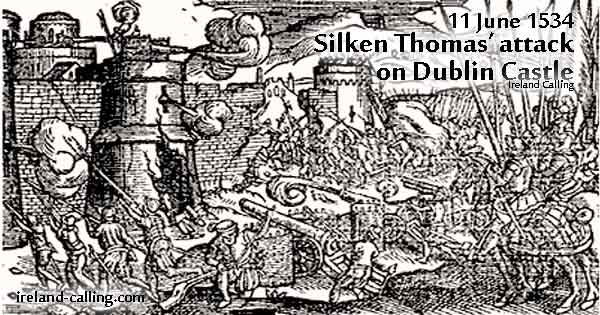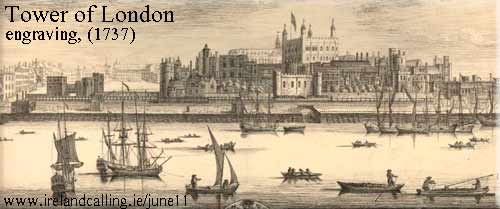Thomas Fitzgerald led an unsuccessful rebellion against the British Crown in Ireland in 1534. He was the 10th Earl of Kildare but was widely known as ‘Silken Thomas’ because of the silk he and his soldiers wore on their helmets.
He came to prominence when his father, Gerald FitzGerald, the 9th Earl of Kildare and Lord Deputy of Ireland, was summoned to London by King Henry VIII, who was Lord of Ireland at that time. The Earl appointed Thomas as his deputy while he was in England.
After he arrived in England, the Earl was placed in the Tower of London to await trial on various charges. The news startled Thomas, who was only 20 at the time. He then became more concerned when he heard rumours that his father had been executed. He responded with a public act of defiance when he rode through Dublin and renounced his allegiance to King Henry in St Mary’s Abbey.
The Lord Chancellor of Ireland, Archbiship Cromer, who was a family friend, pleaded with him to stop and according to stories from the time, Thomas may have started to waver. However, one of his followers, began to praise him and persuaded him to continue with his action to avenge his father’s death.
Thomas then attacked and laid siege to Dublin Castle, the seat of British power in Ireland, but didn’t have the resources to overpower the British defences. In the meantime, Thomas’ father died in London, not from execution but from ill health.

The Archbishop of Dublin, John Allen, had long been hostile to the Fitzgerald family and feared for his safety following the outbreat of the rebellion. He tried to escape by boat on the River Liffey but was captured and taken and brought before Thomas at Artaine. He pleaded for mercy and according to popular tradition, Thomas agreed to spare him. He ordered his men to “take this fellow away” but they, either wilfully or mistakenly, interpreted this as meaning kill him. The Archbishop’s execution led to Thomas being excommunicated by the Pope.
Thomas then lost his stronghold in Kildare to British forces, and his allies started submitting to the mercy of King Henry. He had expected to gain more support for his uprising, particularly from the Catholic Church. However, they refused to help him because of the execution of Archbishop Allen.
Thomas’ army began to dwindle and most of his allies deserted him, but he was still a powerful force. The newly appointed Lord Deputy of Ireland, Lord Leonard Grey, didn’t want to enter into a conflict with Thomas in order to remove him from power. Instead, he guaranteed him a pardon for his crimes against the Crown, if he submitted to King Henry.
Thomas agreed and was sent to the Tower of London in October 1535. He languished in jail for more than a year, hoping to be released but it never happened. Grey’s promise of safety was not honoured by King Henry. Thomas was executed together with his five uncles on 3 February 1537.
The Silken Thomas rebellion brought Ireland sharply into focus for King Henry and his advisers. The powers of the Lord Deputy were reduced. The policy of “surrender and regrant” was introduced. This involved Irish nobles surrendering their land and their titles to the king, who then returned the land along with new titles in return for allegiance to the Crown.

Rebellion of Silken Thomas – 10th Earl of Kildare
